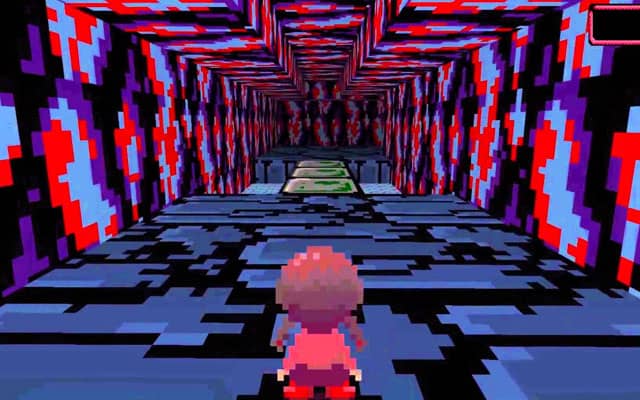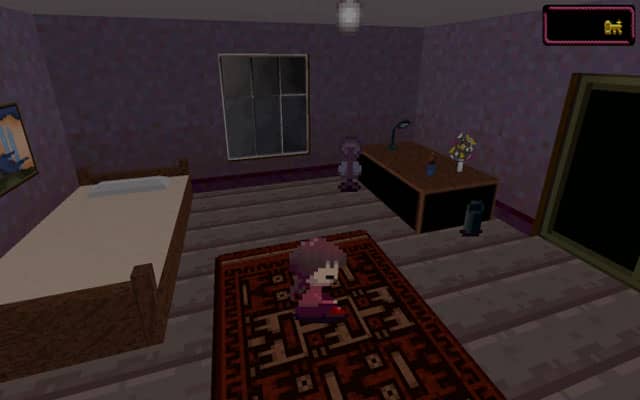Last week, we talked about a weird little Japanese freeware game called “Yume Nikki.” This week, we’re going to take a look at its sequels. Now, you may recall that “Yume Nikki” was made by a reclusive developer who never officially finished making the game. How then, could this have sequels? The answer is that the fans made them. None of these games are official sequels, and with the exception of “Yume Nikki 3D” none of them are at all related to the story of the original game (and even that one is a remake and not a direct continuation). Instead, they focus on using the gameplay of “Yume Nikki” and its uniquely abstract style of story-telling to create a new experience. So they’re sequels in the same way as “Halloween 3.” There are a lot of these sequels out there, “Yume 2kki,” “The Looking Glass,” “Hell Diary” and more. Rather than give you a quick glance at all of these games, I’m going to be specifically focusin in on “.flow” (pronounced “dot flow”), because I feel that it makes the best use of the established pattern to create something new.
“.flow” focuses around the story of a young woman (or possibly a teenage girl) named “Sabitsuki” (which translates into English as “covered in rust”). Like the protagonist of the first game, Sabitsuki refuses to leave her studio apartment except to go to her balcony. However, Sabitsuki’s apartment is far more run down than that of Madotsukai in the first game. The walls are covered in peeling grey paint. The balcony is more rusted. You might notice that this ties in with the character’s name. That is because “.flow” uses motifs as a sort of through-line to guide the player through its abstract narrative. And that is perhaps the most important thing that “.flow” does to differentiate itself from the other sequels. Whereas the original “Yume Nikki” just threw a bunch of symbols at you and told the player “You figure it out,” “.flow” guides the player through a series of surreal but connected images and asks “Have you figured it out yet?” (to say nothing of the other sequels which flail at but fail to grasp the narrative structure of “Yume Nikki”). This is not to say that “.flow” has an unambiguous story. Far from it. However, where “Yume Nikki” left the player trying to figure out what parts were important, “.flow” emphasizes again and again the importance of certain images without saying how they fit together.
 Let’s take a quick look at what those images are. First and foremost, there is the obvious presence of rust all throughout the game. As the game progresses, the rust starts to spread onto Sabitsuki’s skin until (in what is considered to be the game’s “true ending”) the rust completely covers her and she becomes a new character simply referred to as Rust. The next thing that shows up again and again throughout the game is medical imagery, particularly hospitals. There are three separate hospitals in “.flow” and that’s kind of a lot. Then, to connect these two images, as the situation in the hospitals seems to get more dire, they begin to become covered in rust. Then there are the dead bodies everywhere. These come in two varieties. There are the regular old corpses (like the children in one of the hospitals, which also contains a character who looks suspiciously like a young Sabitsuki), but there are also what appear to be reanimated corpses. The walking corpses are the game’s only real sort of enemy, and they are not effected by the game’s sole weapon (a lead pipe) unlike most other NPCs. However, this might be because they already seem to have had their faces caved in with a strong blow or two. So maybe Sabitsuki has used that pipe already. Finally, we have a slum. All roads in the game seem to lead back to the slum (which actually covers 5 areas: a coast, a tenement building, a sewer, a red light district, and a love hotel, in addition to a whole lot of shady back alleys). In the love hotel there is a unique corpse, one lying in a bed which shudders as if it were still alive when Sabitsuki equips the lead pipe. So we’ve got the rust which connects to the hospitals, which connect to the corpses, which connect to the slums.
Let’s take a quick look at what those images are. First and foremost, there is the obvious presence of rust all throughout the game. As the game progresses, the rust starts to spread onto Sabitsuki’s skin until (in what is considered to be the game’s “true ending”) the rust completely covers her and she becomes a new character simply referred to as Rust. The next thing that shows up again and again throughout the game is medical imagery, particularly hospitals. There are three separate hospitals in “.flow” and that’s kind of a lot. Then, to connect these two images, as the situation in the hospitals seems to get more dire, they begin to become covered in rust. Then there are the dead bodies everywhere. These come in two varieties. There are the regular old corpses (like the children in one of the hospitals, which also contains a character who looks suspiciously like a young Sabitsuki), but there are also what appear to be reanimated corpses. The walking corpses are the game’s only real sort of enemy, and they are not effected by the game’s sole weapon (a lead pipe) unlike most other NPCs. However, this might be because they already seem to have had their faces caved in with a strong blow or two. So maybe Sabitsuki has used that pipe already. Finally, we have a slum. All roads in the game seem to lead back to the slum (which actually covers 5 areas: a coast, a tenement building, a sewer, a red light district, and a love hotel, in addition to a whole lot of shady back alleys). In the love hotel there is a unique corpse, one lying in a bed which shudders as if it were still alive when Sabitsuki equips the lead pipe. So we’ve got the rust which connects to the hospitals, which connect to the corpses, which connect to the slums.
Now let’s go back to Sabitsuki’s apartment for a moment. There are a couple of other crucial inversions of the “Yume Nikki” formula to be found in here. Unlike in “Yume Nikki” and its other fan-sequels, the surreal exploration of “.flow” does not take place inside of the character’s dreams. Whereas most of these games use the character’s bed to enter the main portion of the game and her diary or computer to save, “.flow” does the opposite. Sabitsuki uses the bed to save the game, and to enter the “flow” she seemingly passes out in a trance in front of her computer. There is also an implication that what she is doing in the surreal landscape of the flow is having a direct impact on her waking life. You see, as Sabitsuki goes deeper and deeper into the flow, spatters of blood start to appear inside of her apartment.
None of the fan-made sequels even approach the level of being as unique an experience as “Yume Nikki.” However, “.flow” stands out as easily the best in its class. More importantly, “.flow” represents sort of a bridge between “Yume Nikki” and the games which, while not sequels, were still inspired by the simple and effective DIY horror of “Yume Nikki.”








